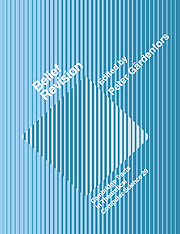Book contents
- Frontmatter
- Contents
- Belief revision: An introduction
- Reason maintenance and belief revision: Foundations versus coherence theories
- Syntax based approaches to belief revision
- A dyadic representation of belief
- On the logic of theory change: More maps between different kinds of contraction functions
- Belief change and possibility theory
- On the difference between updating a knowledge base and revising it
- Planning from first principles
- Autonomous belief revision and communication
- Conditionals and knowledge-base update
- Index
A dyadic representation of belief
Published online by Cambridge University Press: 21 September 2009
- Frontmatter
- Contents
- Belief revision: An introduction
- Reason maintenance and belief revision: Foundations versus coherence theories
- Syntax based approaches to belief revision
- A dyadic representation of belief
- On the logic of theory change: More maps between different kinds of contraction functions
- Belief change and possibility theory
- On the difference between updating a knowledge base and revising it
- Planning from first principles
- Autonomous belief revision and communication
- Conditionals and knowledge-base update
- Index
Summary
INTRODUCTION
Studies of the dynamics of (rational) belief have reached a new degree of sophistication through the formal models developed in particular by Levi (1980) and by Alchourrón, Gärdenfors, and Makinson (the AGM model, Alchourrón et al. 1985 and Gärdenfors 1988). In these models, an individual's beliefs are represented by a set that is closed under logical consequence. The AGM model and its underlying assumptions have had a profound influence on the study of belief base updating in computer science. Although states of belief are, for obvious reasons, represented in computer applications by finite sets of sentences, it is common to demand that “results from an update must be independent of the syntax of the original K[nowledge] B[ase]” (Katsuno and Mendelzon 1989). In other words, operations on finite sets are treated more or less as shadows of operations on the (infinite) logical closures of these sets.
In this paper, a different representation of beliefs will be introduced. A formalized belief state will consist of an ordered pair <K,Cn>. K, or the belief base, is a set of expressions that is not necessarily closed under logical consequence. It represents the basic facts on which an individual grounds her beliefs. Cn is a consequence operator, such that Cn(K) represents her beliefs (namely both the elements of K and the conclusions she draws from them).
- Type
- Chapter
- Information
- Belief Revision , pp. 89 - 121Publisher: Cambridge University PressPrint publication year: 1992
- 42
- Cited by

